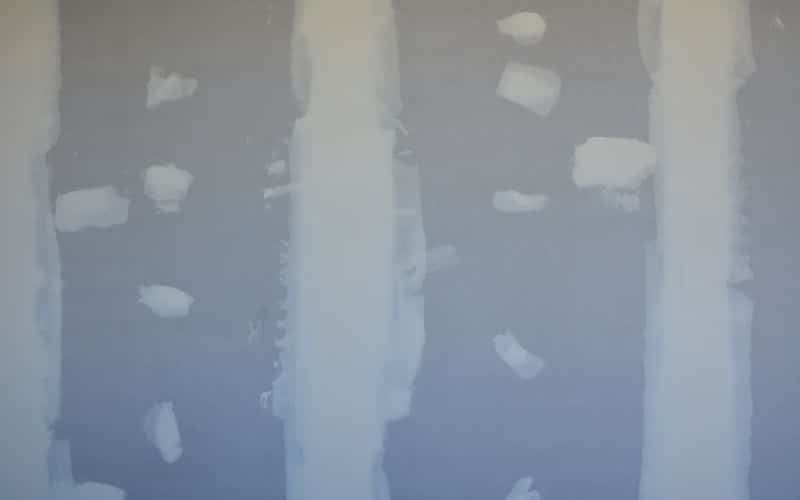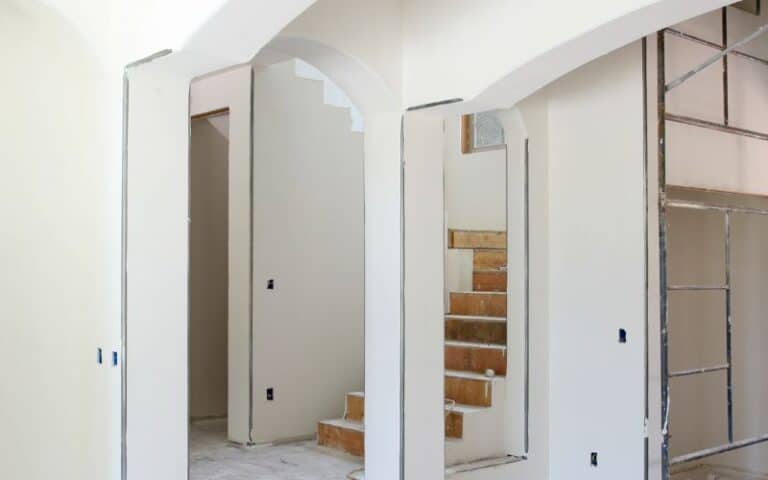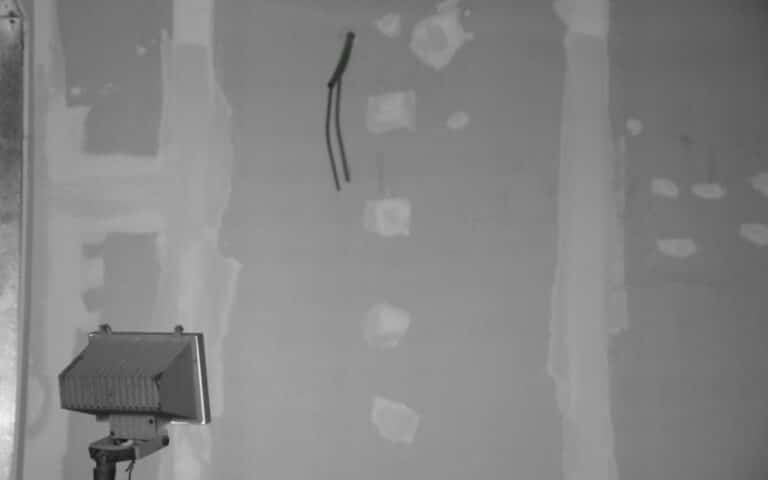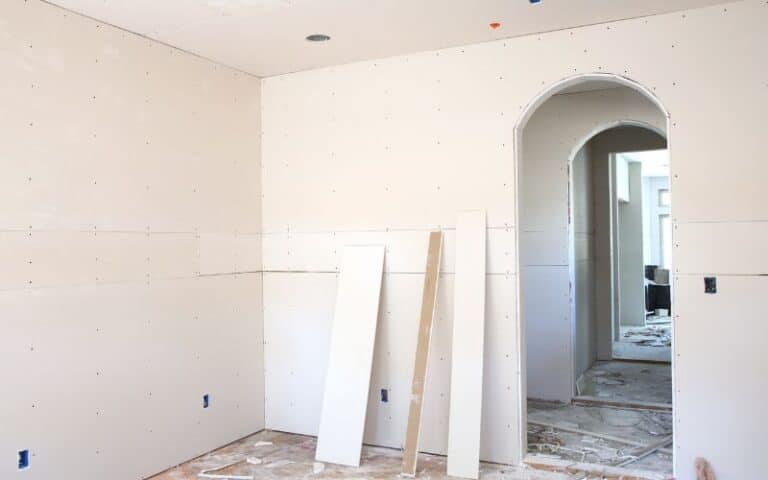Your drywall could get torn due to unfair weather conditions, unusual moisture levels, high-temperature levels, popping nails, or scratches that weren’t fixed on time.
When either happens, you will likely look for ways to fix the drywall and return it to its original state.
If you’ve considered painting over the torn drywall but are unsure if it’s a good decision, you’re in the right place.
You can paint over torn drywall paper as a remedy to fix its appearance without leaving bumps or scratches. However, depending on the damage, you might need more than one coat of paint and need to sand it again. You can also apply primer while you paint over the torn drywall to give it a better-finished look.
In this article, I’ll explain if painting beautifies torn or repaired drywall paper and if you can skim-coat over torn drywall paper.
By the end, you’ll also learn how to fix torn drywall paper before painting and what to use to cover torn drywall paper before painting.
Ready for a Drywall Quiz?
Does Painting Beautify Torn and Repaired Drywall Paper?

Painting over torn drywall paper you’ve recently covered up is a creative way to beautify it.
Also, when you patch up drywall paper without painting over it, it’s likely to appear odd, especially when the rest of the wall is painted.
You’re more likely to be satisfied with your repaired torn drywall paper when it’s made to look seamless with a paint job.
However, if you’re not convinced that painting over repaired drywall is the best option, below is a table showing the pros and cons of doing so;
| Pros of Painting Torn Drywall | Cons of Painting Torn Drywall |
|---|---|
| It helps to beautify the appearance of your drywall. | It can cause more damage when it’s done wrong. |
| It’s the fastest way to repair damaged drywall. | It requires preciseness and special tools. |
| It’s cheaper than replacing drywall paper. | It’s messy and requires deep cleaning afterward. |
| It prevents exposure to further moisture damage. | It could be done unevenly and look displeasing. |
Interestingly, the process of painting over drywall is one that you can do yourself with a few tools.
However, if you’re uncertain how to get a smooth paint job over torn and repaired drywall, below are a few steps that’ll help out:
#1. Cover the Patched Drywall Paper with Primer
After you’ve patched the torn drywall paper, the next thing to do is to get the wall ready for painting.
You’ll need to apply a good primer or sealer to the patched area to serve as a protective coat against moisture.
A primer also serves as a sealing agent that prevents the appearance of particles and bubbles that could make the paint job rough.
However, for your safety, you must ensure that the room is adequately ventilated before you paint so that you don’t inhale toxic chemicals.
Also, allowing your primer or sealer to dry completely before applying any paint is essential.
#2. Ensure That the Wall is Void of Cracks
Next, you’ll need to closely examine the patched drywall paper to ensure no cracks or holes are visible.
This is important because once you paint over it and it’s rough, you must repeat the patch job if holes or cracks are visible.
You can avoid wasting paint by double-checking for cracks before painting.
If you find any cracks, use a light coat of drywall mud to conceal them and let them dry before moving to the next step.
#3. Apply a Base Coat of your Desired Paint
You’ll need to apply some base coat over the primer or sealer you used previously to prepare the area before it’s painted.
Sometimes, you might need to use two layers of base coat to smoothen the area and cover the patched job.
The base coat makes the paint application more manageable and seamless and ensures the paint job has a stronghold.
You must ensure that each layer of the base coat you use dries entirely before you begin painting.
#4. Paint over the Repaired Drywall Paper
Lastly, after you’ve gone through all the steps above with keen attention to detail, you can finally paint over the dry wallpaper.
You’ll need to paint over the drywall paper with light coats until you achieve the desired smooth finish.
Once you’re satisfied with the paint job you’ve done, check that there are no spaces you missed, and then let it dry.
Can You Skim Coat Over Torn Drywall Paper?
You can skim-coat torn drywall paper with drywall mud to rectify the tears; it will be an innovative and long-term solution.
Skim-coating allows you to use several thin layers of drywall mud to repair torn drywall, making it time-consuming.
However, it’s a technique that assures you of a smooth finish, so it’s worth the extra work.
Skim-coating is a cost-effective technique that hides a tear or cracks without leaving uneven marks.
How to Fix Torn Drywall Paper Before Painting?
You can’t paint over torn drywall paper without fixing the tear so that it doesn’t interrupt the paint job.
Luckily, you’d only need drywall mud, primer, a putty knife, a utility knife, and sanding equipment.
It’s also a process that you can get through yourself if you follow the instructions to the letter.
To help you further, below are the steps required to fix torn drywall paper before painting;
#1. Get Rid of the Remnants of Torn Drywall Paper
Removing all the remnants of torn drywall paper left behind after it rips and exposes the drywall is best.
You need to remove these remnants because it’ll be tough to paint over them, and it may roughen the result of the paint job.
To remove the torn drywall paper remnants, you’ll need a sharp razor or utility knife to cut them off to the last bits.
Also, ensure that after you’ve cut off the remnants, the edges of the torn drywall paper are perfectly flat against the wall.
#2. You Must Close up any Exposed Gypsum
Drywall is made from gypsum, so some gypsum gets exposed on the surface when it gets torn. You must close to any exposed gypsum from your drywall to ensure you have a smooth paint job.
This is because gypsum will most likely extract the moisture in the paint being used and leave unwanted bumps on the paint job.
You can cover the exposed gypsum with oil-based paint or drywall primer and sealer to close up the exposed gypsum.
#3. Spread Drywall Mud over the Torn Area
You’ll need some drywall mud to cover the torn area on the drywall paper, and it’s best to spread it in thin coats.
However, for the drywall mud application, you’ll need a putty knife to spread it evenly over the torn surface.
You must ensure that the drywall mud covers at least an inch past the torn area to create a new and smooth surface.
It’s also important to keep the putty knife flat against the wall and use small, thin coats, especially if you’re unfamiliar with the process.
Despite this, if you still have little bumps, rest assured that the next step will help you rectify them.
#4. Sand the Newly Covered Area Thoroughly
After successfully covering the torn area with drywall mud, you’ll also need to sand the site.
For the sanding process, it’s best to stick with the wet method, which you’ll need to do before the drywall mud is cured.
Wet sanding is advised because it fills the holes perfectly without bubbles, unwanted particles, or dust on the floor.
Before the wet sanding, ensure the drywall mud is almost dried but not too wet for a seamless application.
After you’ve confirmed that the drywall mud is damp, use a damp sponge to sand the area carefully until it matches the rest of the wall.
However, if you’re more familiar with the dry sanding method, you can wait for the drywall mud to completely cure before sanding over it.
#5. Cover the Sanding With a Second Layer of Drywall Mud
You’ll need a second coat of drywall mud to smoothen your repairs, no matter which sanding method you use.
Covering a larger area with an equally thin coat is best for the second layer of drywall mud.
When you apply the second layer in thin and well-spread coats, it’ll be impossible to see any rough edges when you paint over it.
However, after applying the second coat, you must sand the area again to give it a smooth and finished look.
What to Cover Torn Drywall Paper with Before Painting?
The best thing to use in covering up torn drywall paper before painting is a joint compound of your choice.
However, it’s best to stick with drywall mud because it adheres better to drywall for repairs.
It’s not advisable to attempt covering up torn, dry wallpaper with paint and nothing else because it’s an unreliable short-term solution.
Luckily, we’ve provided a step-by-step approach for applying drywall mud to your torn drywall paper above.






